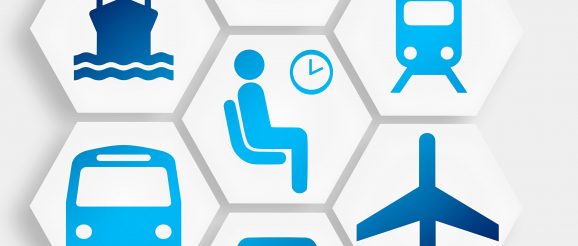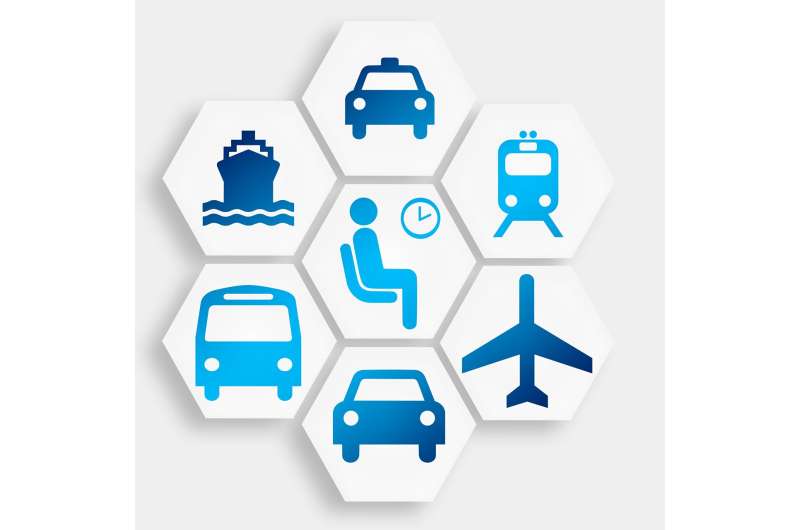Race to cut transportation emissions drives fuel and combustion innovation


This week, aviation industry experts join with the nation’s top energy researchers to discuss strategies for cleaner air transportation that makes the nation less reliant on traditional fossil fuels while slowing climate change.
Their exchange of big-picture ideas represents just a fraction of the solutions scientists at the U.S. Department of Energy’s (DOE’s) National Renewable Energy Laboratory (NREL) are exploring in the race to cut emissions from some of the transportation sectors that pose the greatest challenges.
Planes account for more than 8% of all U.S. transportation-related greenhouse gas (GHG) emissions, while ships and trains each produce less than 2% of these emissions. Even so, a single container ship can emit as much carbon dioxide as 75,000 cars and as much nitrogen oxide and particulate matter as 2.5 million cars. The heavy-duty vehicles used for transcontinental freight trucking generate 23% of the nation’s GHG emissions.
The weight, power, and duty-cycle requirements of these transportation modes, which are jointly responsible for nearly all cargo movement, make them notoriously tough to electrify. At the same time, the country can only achieve climate change goals with deep cuts in their emissions. NREL researchers are working with partners including those represented at the laboratory’s Partner Forum to address these issues with affordable and high-performance fuel and combustion innovations designed to decrease carbon footprints while strengthening national energy security and supply chain resilience.
“On one hand, we’re seeing a relatively rapid shift to electric cars. It’s tougher, however, to virtually eliminate carbon emissions in aviation, marine, and heavy-duty sectors, which will continue to rely on liquid fuels,” said NREL Senior Scientist and Fuels and Combustion Group Manager Gina Fioroni. “Our team is working to make sure new fuels from sustainable sources will burn cleaner while keeping goods and people moving.”
Research reveals how bio-based fuels can slash GHG emissions
Recent NREL breakthroughs offer the potential to slash diesel truck and airplane GHG emissions by 60% to 84%, respectively. The laboratory is exploring options that can provide similar emissions reductions for trains and marine vessels.
So far, bio-based feedstocks including woody biomass residues, agricultural residues, algae, and municipal solid waste show promise as renewable sources for production of these new fuels. NREL researchers assess candidate fuels for efficiency, performance, and stability, as well as techno-economic factors including production costs and feedstock supply chains.
NREL’s longstanding scientific leadership has led to significant discoveries about how fuel properties impact engine operation. Paired with the laboratory’s understanding of industry priorities, as well as advanced simulation and machine learning capabilities, this expertise provides the insights needed for rapid development of market-viable sustainable fuels for long-haul truck, rail, marine, and aviation sectors. The laboratory’s research connects the dots among fuel properties, molecular structure, and engine mechanics, giving industry crucial information to target designs for specific applications.
Identification of dependable, effective fuels with a small carbon footprint and potential for commercial-scale production relies on a sophisticated understanding of how fuel properties impact engine combustion. An innovative combination of fuel property measurements, molecular-level chemistry models, and high-performance computing simulations makes it possible for NREL researchers to pinpoint the best clean, efficient, and cost-competitive solutions for each mode.
Simulations minimize time and cost of fuel performance assessments
Producing large quantities of aviation fuel required for obtaining approval from industry standards authority ASTM International is particularly costly. With simulations, researchers can accurately assess fuel performance in hours or minutes, rather than relying on expensive equipment-based evaluations that can take months. The NREL team can quickly evaluate fuels’ interactions with today’s airplane turbine engines and diesel engines for locomotives, ships, and trucks, as well as explore how new fuels might work with tomorrow’s next-generation engine technologies.
“We’ve been lucky to work with so many great partners—from equipment manufacturers to operators, industry associations, other research institutions, and certification authorities,” said NREL Senior Research Fellow and Advanced Biofuels Team Lead Robert McCormick. “They’ve made it clear how complex, time-consuming, and risky it is to bring new fuels to market. Our team’s work factors in these considerations, with the goal of getting viable new, better fuels to market sooner.”
The NREL team has longstanding relationships with organizations such as ASTM, UL, and the International Organization for Standardization, which are responsible for setting industry standards and practices. Researchers also work closely with partners who manufacture and operate trucking, aviation, rail, construction, mining, military, and agricultural equipment, along with companies that produce fuel and infrastructure equipment.
In addition, the laboratory continues to bridge the transition to full electrification of light-duty and medium-duty vehicles with strategies to maximize biofuel use in the interim. Simultaneously, NREL researchers are working to improve the performance and safety of batteries for electric vehicles.
“Using clean-burning, low-carbon fuel is just one of the strategies needed to reach net-zero emissions for aviation and other forms of transportation,” Fioroni said. “Not only will this help combat climate change, but it will also result in a stronger system for cargo transportation, getting critical supplies to industry and consumers, and delivering the products we need across the country and around the world.”
Race to cut transportation emissions drives fuel and combustion innovation (2022, August 11)
retrieved 11 August 2022
from https://techxplore.com/news/2022-08-emissions-fuel-combustion.html
part may be reproduced without the written permission. The content is provided for information purposes only.
